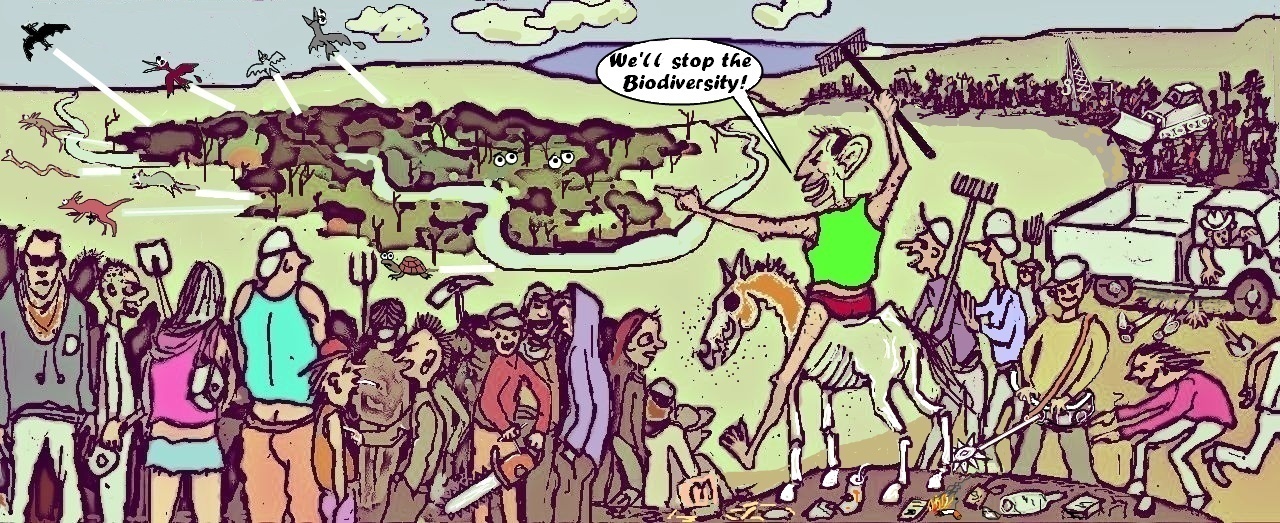Biodiversity's last stand?
To understand how a massive tree planting program can have devastating effects on biodiversity we need to get a picture of how the Green Army battle will play out on the ground, day by day.
Tree planting requires 'preparation' of target sites. Many of the sites selected across Australia for this project will already have vegetative cover. These will be stream banks, wetlands, forest corridors and road verges that, although weedy and 'untidy', still provide critically important habitat for countless fauna species.
To achieve the Coalition's emissions goal of replanting 25000 square kilometres by 2020 it follows that the target sites will be many and as large as possible in every case. Desperate to be time efficient and to get highly visual results quickly, 'preparation' will most likely involve herbicide carpet bombing of weeds, 'wasting' of most existing vegetation, and deployment of heavy armour to smooth landscape and apply mulch. Thus microhabitats are lost, connecting corridors cut and river banks bared. These exposed sites, dotted with newly hatched trees, are customarily then spot-sprayed for years to suppress infiltrating weeds.
Transformation at this speed and scale will alienate large areas of the landscape from biodiversity for many years before trees grow towards maturity and ground cover re-establishes. Depending on location, this will be compromised by climate change factors such as more extreme droughts, floods and fires. Added to this will be the legacy of collateral damage caused by novice Green Army recruits inadvertently eliminating friendly native plant communities, clearing weedy vegetation containing strategic nesting sites, and simply stepping on things.
Desperate to try to achieve its 2020 targets, the Green Army will no doubt largely ignore the newer, science - based practice conditions of 'ecological restoration', which respect the complexity of the environment, call for a careful understanding of the ecology and biodiversity values of each target site and employ a cautious approach by staging work to always provide some cover for fauna.
Why this won't help achieve the 2020 emissions reduction target
Clearing landscape removes vegetation that is already functional as carbon sink. Waste vegetation then breaks down to release more carbon. Typically wood mulch is used in the preparation of tree planting sites, and this releases carbon as it rots down. Young trees are nowhere near as good at sequestering carbon as the grasses and weeds they have replaced and will require years of growth and management before they become effective carbon stores.
So the restoration site becomes a net producer of carbon emissions and not really functional as a carbon sink until years after the 2020 target date, at which time more drastically expensive carbon mitigation measures will be necessary because we will have lost precious time.
But there is a further, overwhelming irony in all this: While the Green Army is busy planting 20 million trees, any gains made will be swallowed up by decisions like the one recently to trash legislation restricting tree clearing in Queensland. This, along with approvals for hundreds of kilometres of new open cut coal mines means it is conceivable that 20 million trees will be cleared in Queensland alone each year out to 2020. And to that we need to add the Coalition's new frontier ideas, like Tony Abbott's proposal for 100 new dams across Australia (millions more trees drowned).
More collateral damage
Other fall-outs from the Green Army plan include potential competition for irrigation water, increases to weed resistance due to heavy and ongoing use of herbicides, more nutrient and herbicide run-off into waterways delivering blue-green algae problems and toxic impacts on estuaries, vulnerability of cleared sites to increased erosion, ongoing costs to ratepayers through pressure on local communities to create project opportunities for the green Army and then pick up the pieces after they leave, and the rapid growth in numbers of poor quality, 'fly-by-night' contractors, in response to opportunities provided by projects started by the Green Army. All this creating potential for problems like those experienced with the home insulation program.
Knowing what we know
In 2002, Donald Rumsfeld, desperate to explain away the Bush administration's failing basis for war in Iraq, made his infamous 'unknown unknowns' speech. Nobody understood what he was talking about.
But applied to the Coalition's Direct Action policy it all becomes terribly clear: For Direct Action, the 'known knowns' are the clear indications that the Coalition in Government will abandon their costly carbon mitigation measures under the pretext that will be set by their 'commission of audit' – a sham process routinely trotted out by incoming conservative governments which will 'uncover' - to much mock horror - a whole set of economic unknowns unknowns that we all knew weren't too bad until the audit turned them into unknown knowns (really, really bad).
This may leave the Green Army standing alone as the Coalition's main carbon mitigation tool, and while it certainly won't lead to victory on the emissions reductions front, this clumsy 'green' idea may well end up defeating biodiversity across big slabs of the Australian landscape.
